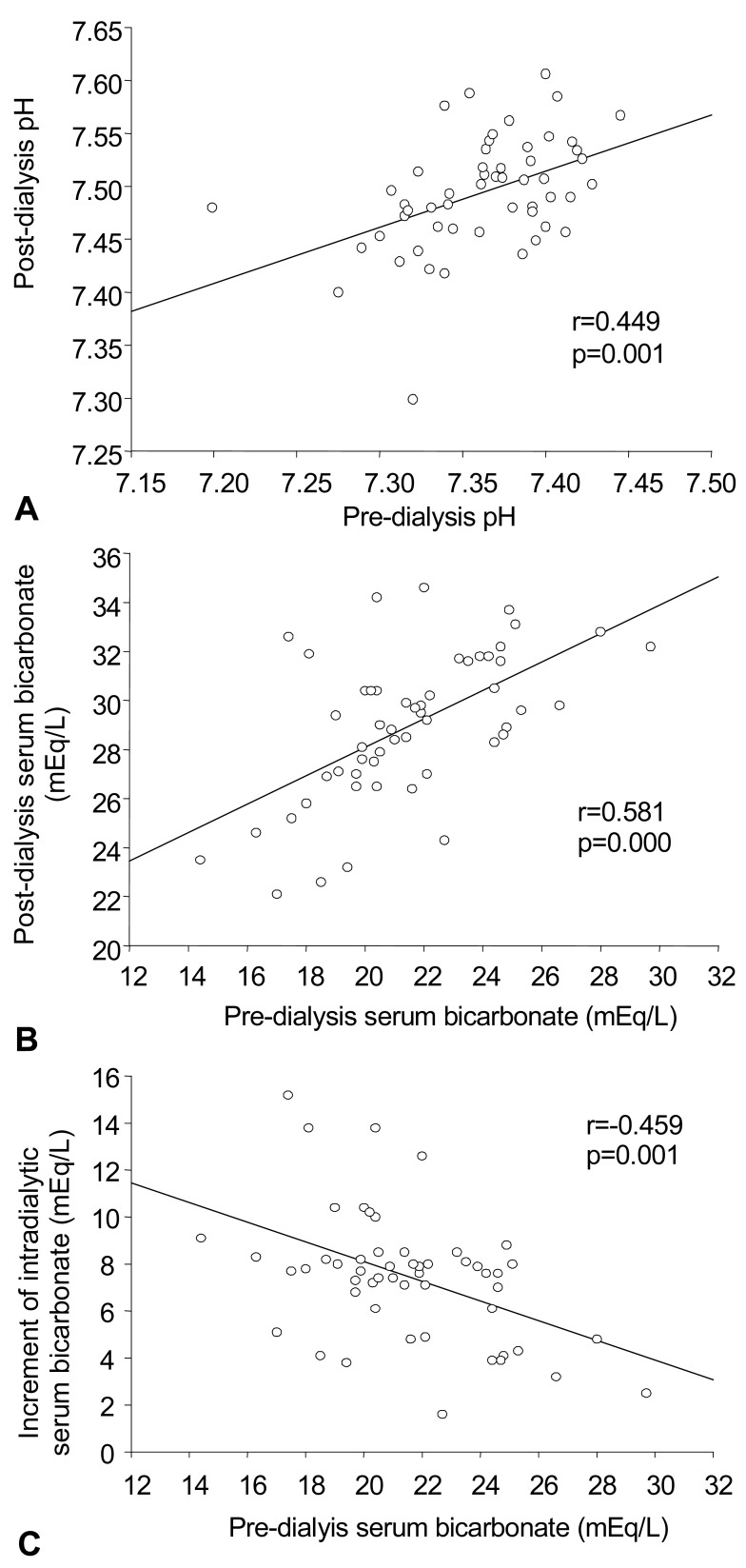Electrolyte Blood Press.
2007 Dec;5(2):95-101. 10.5049/EBP.2007.5.2.95.
Varying Dialysate Bicarbonate Concentrations in Maintenance Hemodialysis Patients Affect Post-dialysis Alkalosis but not Pre-dialysis Acidosis
- Affiliations
-
- 1Department of Internal Medicine, Hanyang University Guri Hospital, Guri, Korea. kimhj@hanyang.ac.kr
- KMID: 2052291
- DOI: http://doi.org/10.5049/EBP.2007.5.2.95
Abstract
- This study aimed to assess the effects of different dialysate bicarbonate concentrations in correcting acid-base imbalance in 53 stable hemodialysis patients in a university-hemodialysis unit. Three different bicarbonate concentrations were assigned, i.e. 25 mEq/L in 10, 30 mEq/L in 30, and 35 mEq/L in 13 patients. Blood gas analyses from arterial line blood samples before and after dialysis in the mid-week were performed for the determination of pH and serum bicarbonate concentration ([HCO3-]). The mean values of predialysis arterial [HCO3-] were mildly acidotic in all 3 groups, but not significantly different among them, whereas those of post-dialysis arterial [HCO3-] were alkalotic, especially in the group of 35 mEq/L as compared with the other two groups. The mean blood pH was not significantly different among the 3 groups. As expected, there was a positive correlation between pre-dialysis pH and post-dialysis pH (r=0.45, p=0.001), and pre-dialysis [HCO3-] and post-dialysis [HCO3-] (r=0.58, p=0.000), but with a negative correlation between pre-dialysis [HCO3-] and the increment of intradialytic [HCO3-] following hemodialysis (r=-0.46, p=0.001). In conclusion, this study shows that the impact of conventional dialysate bicarbonate concentrations ranging from 25 to 35 mEq/L is not quite different on the mild degree of predialysis acidemia, but the degree of postdialysis alkalemia is more prominent in higher bicarbonate concentrations. Base supply by hemodialysis alone does not seem to be the main factor to determine the predialysis acidosis in end-stage renal disease patients on chronic maintenance hemodialysis.
MeSH Terms
Figure
Reference
-
1. Mehrotra R, Kopple JD, Wolfson M. Metabolic acidosis in maintenance dialysis patients: clinical considerations. Kidney Int Suppl. 2003; 64(88):S13–S25. PMID: 14870874.2. Swendseid ME, Wang M, Vyhmeister I, Chan W, Siassi F, Tam CF, Kopple JD. Amino acid metabolism in the chronically uremic rat. Clin Nephrol. 1975; 3:240–246. PMID: 237643.3. Graham KA, Reaich D, Channon SM, Downie S, Gilmour E, Passlick-Deetjen J, Goodship TH. Correction of acidosis in CAPD decreases whole body protein degradation. Kidney Int. 1996; 49:1396–1400. PMID: 8731105.
Article4. Uribarri J, Levin NW, Delmez J, Depner TA, Ornt D, Owen W, Yan G. Association of acidosis and nutritional parameters in hemodialysis patients. Am J Kidney Dis. 1999; 34:493–499. PMID: 10469860.
Article5. Bommer J, Locatelli F, Satayathum S, Keen ML, Goodkin DA, Saito A, Akiba T, Port FK, Young EW. Association of predialysis serum bicarbonate levels with risk of mortality and hospitalization in the Dialysis Outcomes and Practice Patterns Study (DOPPS). Am J Kidney Dis. 2004; 44:661–671. PMID: 15384017.
Article6. Wu DY, Shinaberger CS, Regidor DL, McAllister CJ, Kopple JD, Kalantar-Zadeh K. Association between serum bicarbonate and death in hemodialysis patients: Is it better to be acidotic or alkalotic? Clin J Am Soc Nephrol. 2006; 1:70–78. PMID: 17699193.
Article7. Kopple JD. National kidney foundation K/DOQI clinical practice guidelines for nutrition in chronic renal failure. Am J Kidney Dis. 2001; 37(Suppl 2):S66–S70. PMID: 11158865.
Article8. Rault R. Optimal dialysate bicarbonate during hemodialysis. ASAIO Trans. 1991; 37:M372–M373. PMID: 1751193.9. Kovacic V, Roguljic L, Kovacic V. Metabolic acidosis of chronically hemodialyzed patients. Am J Nephrol. 2003; 23:158–164. PMID: 12649614.
Article10. Agroyannis B, Fourtounas C, Tzanatos H, Dalamangas A, Vlahakos DV. Relationship between interdialytic weight gain and acid-base status in hemodialysis by bicarbonate. Artif Organs. 2002; 26:385–387. PMID: 11952511.
Article11. Zucchelli P, Santoro A. Correction of acid-base balance by dialysis. Kidney Int Suppl. 1993; 43(41):S179–S183. PMID: 8320915.12. Messa P, Mioni G, Maio GD, Ferrando C, Lamperi D, Famularo A, Paoletti E, Cannella G. Derangement of acid-base balance in uremia and under hemodialysis. J Nephrol. 2001; 14(Suppl 4):S12–S21. PMID: 11798141.13. Soudan K, Ricanati ES, Leon JB, Sehgal AR. Determinants of metabolic acidosis among hemodialysis patients. Hemodial Int. 2006; 10:209–214. PMID: 16623676.
Article14. Williams AJ, Dittmer ID, McArley A, Clarke J. High bicarbonate dialysate in haemodialysis patients: effects on acidosis and nutritional status. Nephrol Dial Transplant. 1997; 12:2633–2637. PMID: 9430864.
Article15. Oettingger CW, Oliver JC. Normalization of uremic acidosis in hemodialysis patients with a high bicarbonate dialysate. J Am Soc Nephrol. 1993; 3:1804–1807. PMID: 8329675.16. Graham KA, Hoenich NA, Goodship THJ. Pre and interdialytic acid-base balance in hemodialysis patients. Int J Artif Organs. 2001; 24:192–196. PMID: 11394698.
Article17. Kraut JA. Disturbances of acid-base balance and bone disease in end-stage renal disease. Semin Dial. 2000; 13:261–266. PMID: 10923356.
- Full Text Links
- Actions
-
Cited
- CITED
-
- Close
- Share
- Similar articles
-
- Effects of Acetate & Bicarbonate Dialysate In Patients with Maintenance Hemodialysis
- Sodium Balance in Maintenance Hemodialysis
- Successful Treatment of Severe Lactic Acidosis by Continuous Venovenous Hemodiafiltration
- The Effect of Dialysate Temperature on Blood Pressure, Core Temperature, and Physical Symptoms in Hemodialysis Patients
- The Effects of Low Sodium Dialysate in Hemodialysis Patients


